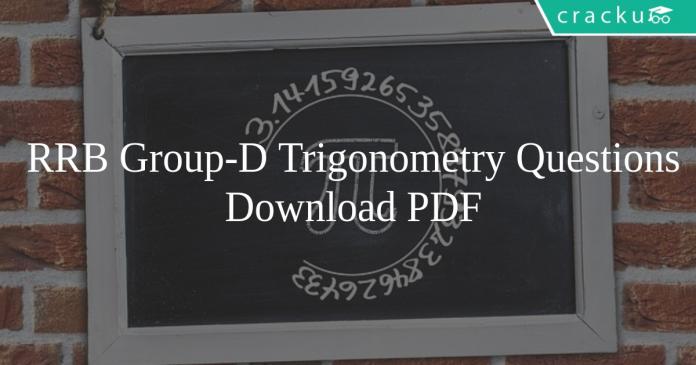RRB Group-D Trigonometry Questions PDF
Download Top 20 RRB Group-D Trigonometry Questions and Answers PDF. RRB Group-D Maths questions based on asked questions in previous exam papers very important for the Railway Group-D exam.
Download RRB Group-D Trigonometry Questions PDF
Download RRB Group-D Previous Papers PDF
Take a RRB Group-D free mock test
Question 1: $5tan\theta = 4$, then the value of $(\frac{5sin\theta – 3cos\theta}{5sin\theta + 3cos\theta})$ is
a) $\frac{1}{7}$
b) $\frac{2}{7}$
c) $\frac{5}{7}$
d) $\frac{2}{5}$
Question 2: The least value of $(4sec^2\theta + 9cosec^2\theta)$ is
a) 1
b) 19
c) 25
d) 7
Question 3: If $x=cosec\theta-sin\theta$ and $y=sec\theta-cos\theta$, then the value of $x2y2(x2 + y2 + 3)$
a) 0
b) 1
c) 2
d) 3
Question 4: If $ 0 \leq \theta \leq \frac{\pi}{2}$, $2ycos\theta=sin\theta$ and $\frac{x}{2cosec\theta}=y$, then the value of $x^2-4y^2$ is
a) 1
b) 2
c) 3
d) 4
Question 5: If $sin\theta + \sin^2\theta = 1$, then the value of cos12$\theta$ + 3cos10$\theta$ + cos6$\theta$ + 3cos8$\theta$ – 1 is
a) 0
b) 1
c) -1
d) 2
Take a free mock test for RRB Group-D
Question 6: The value of $\frac{1}{cosec\theta – cot\theta} – \frac{1}{sin\theta}$
a) $cot\theta$
b) $cosec\theta$
c) $tan\theta$
d) $1$
Question 7: If $\cos\theta + \sin\theta = \sqrt{2}\cos\theta$, then $\cos\theta – \sin\theta$ is
a) -$\sqrt{2}\cos\theta$
b) -$\sqrt{2}\sin\theta$
c) $\sqrt{2}\sin\theta$
d) $\sqrt{2}\tan\theta$
Question 8: If $cos^4\theta-sin^4\theta=\frac{2}{3}$, then the value of $1-2sin^2\theta$ is,
a) 0
b) $\frac{2}{3}$
c) $\frac{1}{3}$
d) $\frac{4}{3}$
Question 9: If $tan\theta$ = 3/4 and $\theta$ is acute, then $cosec\theta$ is equal to
a) $\frac{5}{3}$
b) $2$
c) $\frac{1}{2}$
d) $4$
Question 10: The value of $\frac{1}{1 + tan^2\theta}$ + $\frac{1}{1 + cot^2\theta}$ is
a) 1
b) 2
c) $\frac{1}{2}$
d) $\frac{1}{4}$
RRB Group D previous year papers
Question 11: Maximum value of $(2sin\theta+3 cos\theta)$ is
a) 2
b) $\sqrt{13}$
c) $\sqrt{15}$
d) 1
Question 12: If $Cos \Theta + Sec\Theta = 2$, find $Cos^{2017} \Theta + Sec^{2017}\Theta $
a) 2
b) 3
c) 1018
d) 2017
Question 13: If $\sin x+\frac{1}{\sin x}=2$ then $\cos ^5 x+\cot ^{5} x=?$
a) 0
b) -1
c) 1
d) 2
770 Mocks (cracku Pass) Just Rs.199
Question 14: If $cos^2x + (1 + sinx)^2 = 3$, then find the value of cosec x + sin(60+x), where 0º < x < 90º?
a) 3
b) 2
c) $2\frac{1}{2}$
d) $3\frac{1}{2}$
Question 15: If $x$ and $y$ are acute angles such that their sum is less than $90^{\circ}$ . If $\cos(2x-20^{\circ})=\sin(2y+20^{\circ})$ , then the value of $\tan(x+y)$ is
a) $0$
b) $1$
c) $\frac{1}{\sqrt{3}}$
d) $\sqrt{3}$
Question 16: If x is an acute angle such that
Tan (4x – 50°) = Cot ( 50° – x), then the value of x would be?
a) 60
b) 45
c) 50
d) 30
RRB Group-D Important Questions (download PDF)
Question 17: If cosec 9x= sec 9x (0 <x<10), what is the value of x?
a) 9°
b) 3°
c) 5°
d) 6°
Question 18: If $\sin x+1=\frac{2}{\sin x} $ then $\cos ^3 x+ \mathrm{cosec} ^{-3} x=?$
a) 0
b) -1
c) 1
d) 2
Question 19: If $\frac{sin2x}{sinx} + cos2x + sin^2x = 0$, find the value of x, if $0 \leq x \leq 180$.
a) 45º
b) 90º
c) 180º
d) More than one value is possible
Question 20: If $\frac{sin^2 \Theta}{4} = \frac{cos^2 \Theta}{9}$. Find the value of $tan^2 \Theta – cot^2 \Theta$.
a) 1/6
b) 13/27
c) 1/18
d) None of these
General Science Notes for RRB Exams (PDF)
Answers & Solutions:
1) Answer (A)
Taking $cos\theta$ outside in numerator and in denominator and making $tan\theta$
hence eq will be $(\frac{5tan\theta – 3}{5tan\theta + 3})$
As it is given that $5tan\theta$ = 4
after putting values and solving we will get the equation reduced to 1/7.
2) Answer (A)
$4sec^2\theta+9cosec^2\theta$
or $4+4tan^2\theta+9+9cot^2\theta$
or $13+4tan^2\theta+9cot^2\theta$
or $ 13+4tan^2\theta+\frac{9}{tan^2\theta} $
or $ 13-12+(2tan\theta+\frac{3}{tan\theta})^2 $ (eq. (1) )
or now above expression to be minimum, equation $(2tan\theta+\frac{3}{tan\theta})^2$ should be minimum.
So applying $A.M.\geq G.M. $
$\frac{(2tan\theta +\frac{3}{tan\theta})}{2} \geq \sqrt{6}$
or ${(2tan\theta+\frac{3}{tan\theta})}=2\sqrt{6}$ ( for value to be minimum)
After putting above value in eq.(1) , we will get least value of expression as 25.
3) Answer (B)
$x=cosec\theta – sin\theta=\frac{cos^2\theta}{sin\theta}=cot\theta cos\theta$
Similarly $y=tan\theta sin\theta$
$xy=sin\theta cos\theta$
$x^2+y^2+3=(sec^2\theta +cosec^2\theta )$
Now putting above values in given equation, and after solving it will be reduced to 1
4) Answer (A)
$2y=tan\theta$
$x=2ycosec\theta$
Hence value of $x^2 – 4y^2 $ = $4y^2(cosec^2\theta – 1)$
or $tan^2\theta cot^2\theta$ = 1
5) Answer (A)
Given equation can be written as $(cos^4\theta + cos^2\theta)^3 -1$
as $sin\theta + sin^2\theta = 1$
or $sin\theta = cos^2\theta$
putting above value in given equation it will be
$(sin^2\theta + sin\theta)^3 -1 = 0$
6) Answer (A)
$\frac{sin\theta}{1-cos\theta} – \frac{1}{sin\theta}$
or $\frac{cos\theta – cos^2\theta}{(1-cos\theta)sin\theta}$ = $cot\theta$
7) Answer (C)
$\sin^2 \theta + \cos^2 \theta = 1$
So, $\sin^2 \theta + \cos^2 \theta + 2\sin\theta * \cos \theta = 2 \cos^2\theta$
Hence, $\cos^2 \theta – \sin^2 \theta = 2 \sin\theta*\cos\theta$
So, $\cos\theta – \sin\theta = \sqrt{2}\sin\theta$
8) Answer (B)
$cos^4\theta-sin^4\theta=(cos^2\theta-sin^2\theta)(cos^2\theta+sin^2\theta)=cos^2\theta-sin^2\theta=\frac{2}{3}$
$cos^2\theta-sin^2\theta =1-2sin^2\theta=\frac{2}{3}$
9) Answer (A)
$\frac{sin \theta}{cos \theta} = \frac{3}{4}$
So, $\frac{sin^2\theta}{cos^2\theta}=\frac{9}{16}$
Hence, $sin^2 \theta = \frac{9}{9+16}=\frac{9}{25}$
So, $cosec \theta = \frac{5}{3}$
10) Answer (A)
$1 + \tan ^2 \theta = \sec ^2 \theta$
$1 + \cot ^2 \theta = \csc ^2 \theta$
So, the given fraction becomes,
$\frac{1}{\sec ^2 \theta} + \frac{1}{\csc ^2 \theta} = \sin^2\theta + \cos^2 \theta = 1$
11) Answer (B)
$\because$ Maximum Value of $a\sin{\theta}+b\cos{\theta}=\sqrt{a^{2}+b^{2}}$
$\therefore$ Maximum Value of $2\sin{\theta}+3\cos{\theta}=\sqrt{2^{2}+3^{2}}$
$=\sqrt{13}$
Hence, Correct option is B.
12) Answer (A)
$Cos \Theta + Sec\Theta = 2$
$(Cos \Theta + Sec\Theta )^2 = 2^2$
==> $Cos^2 \Theta + Sec^2\Theta + 2 Cos \Theta * Sec \Theta = 4$ (Note :Cos \Theta * Sec \Theta = 1)
==> $Cos^2 \Theta + Sec^2\Theta +2 = 4$
==> $Cos^2 \Theta + Sec^2\Theta $ = 2
$(Cos \Theta + Sec\Theta )^3 = 2^3$
==> $(Cos^3 \Theta + Sec^3\Theta + 3*Cos \Theta * Sec \Theta(Cos \Theta + Sec\Theta) = 2^3$
==> $(Cos^3 \Theta + Sec^3\Theta$ = 2
Therefore, irrespective of the power, the expression always equals to 2.
13) Answer (A)
$\sin x+\frac{1}{\sin x}=2$
=>$\sin^2 x+1=2\sin x$
=>$(\sin x-1)^2=0$
=>$\sin x = 1$
=>$\cos x = 0$
The given expression would be,
$\cos ^5 x+\cot ^{5} x$
$\cos ^5 x+\frac{\cos^5 x}{\sin^5 x}$
$=0$
14) Answer (A)
$cos^2x + (1 + sinx)^2 = 3$
=> $cos^2x + 1 + sin^2x + 2sinx = 3$ (Since $ cos^2x + sin^2x = 1$)
=> $2 sin x = 1$ or sin x = ½ which means x=30 degrees [Solution in the first quadrant]
=> cosec x = 1/sin x = 2 and sin (60+x) = sin 90 = 1
=> The value of the expression is 2+1 = 3
15) Answer (B)
Given that , $x+y<90^{\circ} \dots (1)$
$\implies\cos(2x-20^{\circ})=\cos(90^{\circ}-(2y+20^{\circ}))$
Using the given property in $(1)$
$\implies 2x-20^{\circ}=70^{\circ}-2y$
$\implies 2x+2y=90^{\circ}$
$\implies x+y=45^{\circ}$
$\implies \tan(x+y)=1 $
Hence , the correct option is B
16) Answer (D)
We know that Tan ( 90 – x) = Cot x and Cot (90 – x) = Tanx
So 4x – 50 = 90 – y
Then 50 – x will be y
=> y = 50 – x
x + y = 50
Moreover,
90 – y = 4x – 50
=> 4x + y = 140
Subtracting the two equations, we get
3x = 90
=> x = 30
Hence the correct answer is option D.
17) Answer (C)
If cosec 9x= sec 9x,
Then $\sin 9x=\cos 9x$
In the first quadrant cos and sin are equal when $9x =45$°
Hence, x = 5°
18) Answer (C)
$\sin x+1=\frac{2}{\sin x} $
=>$\sin^2 x+\sin x=2$
=>$(\sin x-1)(\sin x+2)=0$
As $\sin x$ can only take values between -1 and 1,
=>$\sin x = 1$
=>$\cos x = 0$
The given expression would be,
$\cos ^3 x+ \mathrm{cosec}^{-3} x$
$\cos ^3 x + \sin^3 x$
$=1$
19) Answer (B)
$\frac{sin2x}{sinx} + cos2x + sin^2x = 0$
We know that $sin2x = 2 sinx cosx$ and $cos2x=cos^2x-sin^2x$
=> $2cosx + cos^2x = 0$
=> cos x =0 or cos x =2
Now, cos x =2 is not possible.
=> cos x = 0
In the range, $0 \leq x \leq 180$, cos x =0 at only 90º
Thus, B is the correct answer.
20) Answer (D)
$\frac{sin^2 \Theta}{4} = \frac{cos^2 \Theta}{9}$
==> $\frac{sin^2 \Theta}{cos^2 \Theta}$ = $\frac{4}{9}$
==> $tan^2 \Theta = \frac{4}{9}$
==> $cot^2 \Theta = \frac{9}{4}$
==> $tan^2 \Theta – cot^2 \Theta$ = 4/9 – 9/4 = -65/36
Since there is no such option, the correct option to choose is D.
DOWNLOAD APP FOR RRB FREE MOCKS
We hope this Trigonometry Questions for RRB Group-D Exam will be highly useful for your preparation.





